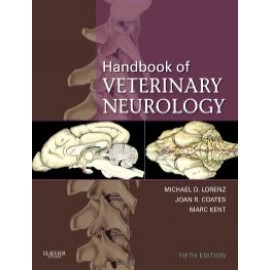Handbook of Veterinary Neurology, 5th Edition - Lorenz
Descripcion del producto
| ISBN Number | 9781437706512 |
| Main Author | By Michael D. Lorenz, BS, DVM, DACVIM, Joan Coates, BS, DVM, MS, DACVIM and Marc Kent, DVM, BA, DACVIM |
| Copyright Year | 2011 |
| Edition Number | 5 |
| Format | Book |
| Trim | 276 x 216 (8 1/2 x 10 7/8) |
| Illustrations | 165 illus. |
| Imprint | Saunders |
| Page Count | 560 |
| Publication Date | 14 Dec 2010 |
| Stock Status | IN STOCK |
Book Description
Handbook of Veterinary Neurology provides quick access to vital information on neurologic conditions in a wide range of species including canine feline bovine caprine equine ovine and porcine. A problem-oriented approach makes it easy to diagnose and treat neurologic problems in small and large animals. The coverage of disorders by problem not by established disease diagnosis emulates how animals present to the veterinary hospital and simplifies the formulation of a correct diagnosis. Within each chapter discussions of neurologic disease include a review of the localization criteria and the diseases that can cause that problem plus treatment and surgical techniques. Lead author Michael D. Lorenz brings decades of experience to neurologic assessment using a diagnostic approach that requires minimal knowledge of neuroanatomy.
New to this edition
- A companion website includes 20 narrated video clips with accompanying PowerPoint slides that correlate to the case histories in the book, covering neurologic assessment and clinical problems such as paresis of one limb, tetraparesis, stupor, seizures, ataxia of the head and limbs, and cranial nerve disorders.
- Two new co-authors, Jean Coates and Marc Kent, board-certified in neurology, enhance the credibility of this edition.
- A full-color design and numerous illustrations include enhanced images of neuroanatomy and pathology.
Key Features
- A problem-based approach is organized by presenting sign rather than by condition, guiding you to logical conclusions regarding diagnosis and treatment.
- Algorithms diagram the logic necessary to localize lesions and to formulate diagnostic plans.
- Coverage of current diagnostic techniques includes the use of diagnostic tools, such as radiology, spinal fluid analysis, electrodiagnosis, and MR imaging.
- Case histories in each chapter present a problem and the results of the neurologic examination, then ask you to solve the problem by localizing the lesion, listing probable causes, and making a diagnostic plan. Answers are provided at the back of the book.
- A consistent format for each case history includes signalment, history, physical examination findings, and neurologic examination.
- A comprehensive appendix describes species and breeds that have a congenital predisposition for particular neurologic diseases.
- Extensive references make it easy to pursue in-depth research of more advanced topics.
Author Information
Book Contents
Part I: Fundamentals
1. Neurologic History, Neuroanatomy, and Neurologic Examination
2. Localization of Lesions in the Nervous System
3. Disorders of Micturition
4. Confirming a Diagnosis
Part II: Clinical Problems: Signs and Symptoms
5. Paresis of One Limb
6. Pelvic Limb Paresis, Paralysis, or Ataxia
7. Tetraparesis, Hemiparesis, and Ataxia
8. Ataxia of the Head and Limbs
9. Disorders of the Face, Tongue, Esophagus, Larynx, and Hearing
10. Disorders of Involuntary Movement
11. Blindness, Anisocoria, and Abnormal Eye Movements
12. Stupor or Coma
13. Seizures, Narcolepsy, and Cataplexy
14. Pain
15. Systemic or Multifocal Signs
Appendix: Breed-Specific Neuromuscular Diseases in Domestic Animals



